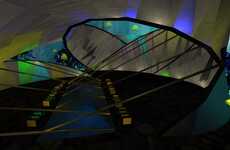
The Farrell Centre Debuts Its Inaugural Exhibition
References: farrellcentre.org.uk & dezeen
The exploration of future building materials that are suitable for a planet in a climate crisis and answer the needs of ever-expanding urban centers have been a strong focus for many contemporary architects. Recently, an exhibition titled 'More with Less: Reimagining Architecture for a Changing World' looks into future building materials and their potential to adapt and persevere during global warming. Fake fur, mycelium, and wool insulation are some of the materials in the spotlight.
The 'More with Less: Reimagining Architecture for a Changing World' exhibition is the inaugural show of the newly opened Farrell Centre, located in Newcastle, England. The institution, which doubles as a research center and community space, was founded by British architect Terry Farrell "who donated his architectural archive and put £1 million towards the build."
Image Credit: Dezeen
The 'More with Less: Reimagining Architecture for a Changing World' exhibition is the inaugural show of the newly opened Farrell Centre, located in Newcastle, England. The institution, which doubles as a research center and community space, was founded by British architect Terry Farrell "who donated his architectural archive and put £1 million towards the build."
Image Credit: Dezeen
Trend Themes
1. Future Building Materials - Exploration of alternative building materials suitable for a planet in a climate crisis brings opportunities for innovation in sustainable construction.
2. Adaptive Architecture - Investigating materials with resilience and adaptability against global warming represents disruptive innovation opportunities for architects and builders.
3. Community Research Centers - The integration of research centers within community spaces offers the chance for innovation in interdisciplinary collaboration and community engagement.
Industry Implications
1. Construction - The construction industry can evolve through the implementation of sustainable building materials that have a reduced environmental impact.
2. Architecture - Architecture industry has opportunities for disruptive innovation through the redevelopment of materials and design processes that increase climate change resilience.
3. Research and Development - Innovation in interdisciplinary collaboration and community engagement can benefit from the establishment of community research centers.
6.3
Score
Popularity
Activity
Freshness























